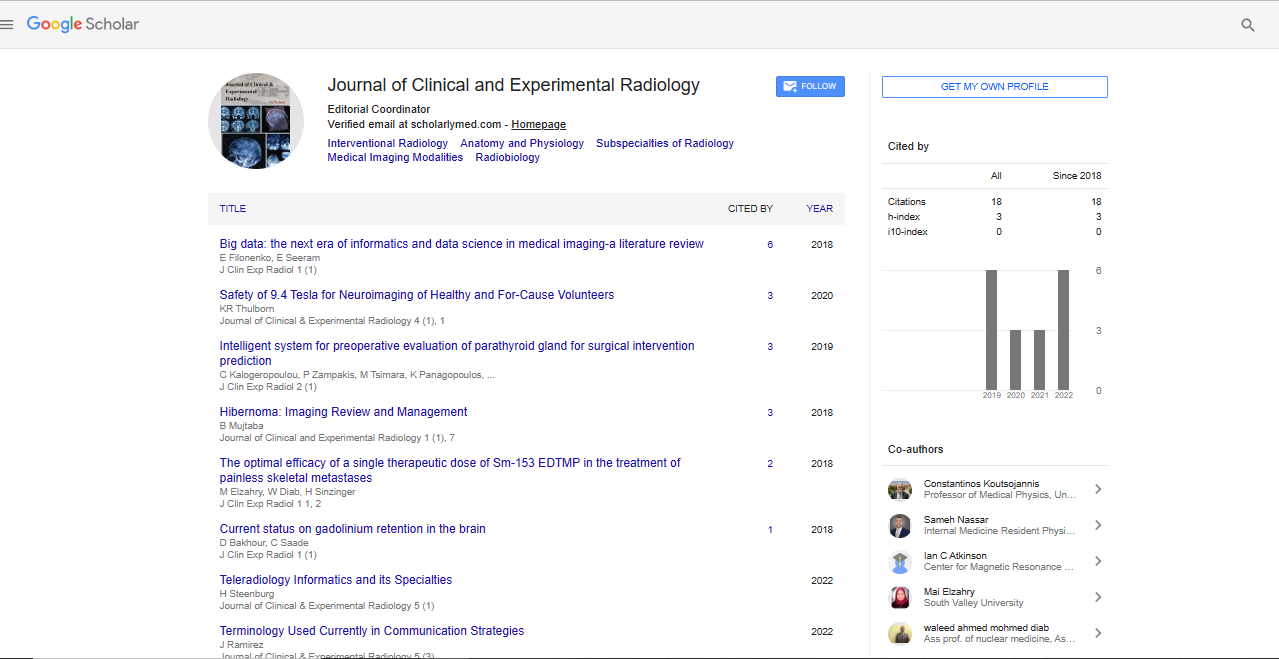Opinion Article, J Clin Exp Radiol Vol: 6 Issue: 2
Imaging Techniques for the Accurate Assessment of Liver Disease
Guen Choi*
1Department of Medicine, Sungkyunkwan University School of Medicine, Seoul, South Korea
*Corresponding Author: Guen Choi,
Department of Medicine, Sungkyunkwan
University School of Medicine, Seoul, South Korea
E-mail: guen@choi.edu
Received date: 28 May, 2023, Manuscript No. JCER-23-106676
Editor assigned date: 31 May, 2023, Pre QC No. JCER-23-106676 (PQ);
Reviewed date: 14 June, 2023, QC No. JCER-23-106676
Revised date: 22 June, 2023, Manuscript No. JCER-23-106676 (R);
Published date: 28 June, 2023, DOI: 07.4172/jcer.1000137
Citation: Choi G (2023) Imaging Techniques for the Accurate Assessment of Liver Disease. J Clin Exp Radiol 6:2.
Description
Liver diseases encompass a wide range of conditions that can lead to significant morbidity and mortality. Accurate assessment of liver health is essential for diagnosis, staging, and monitoring of these diseases. Over the years, various imaging techniques have been developed to visualize and evaluate the liver non-invasively. These techniques provide valuable information about liver structure, function, and blood flow. This study discuss the different imaging modalities used in the assessment of liver diseases, highlighting their principles, applications, and advancements.
Ultrasound is a widely used imaging modality for evaluating liver diseases due to its accessibility, safety, and cost-effectiveness. It utilizes high-frequency sound waves to provide real-time images of the liver. Ultrasound can detect liver steatosis (fatty liver), evaluate liver size and contour, assess focal lesions (such as tumors or cysts), and guide interventional procedures like biopsies or drainages. Recent advancements in ultrasound technology, such as elastography and Contrast-Enhanced Ultrasound (CEUS), have improved its diagnostic capabilities. Elastography measures liver stiffness, which can indicate fibrosis or cirrhosis. CEUS involves the injection of contrast agents to enhance the visualization of blood flow within the liver and improve the detection of focal liver lesions.
Computed Tomography (CT) provides detailed cross-sectional images of the liver by using X-rays and computer algorithms. It is particularly valuable for assessing liver tumors, vascular abnormalities, and hepatic masses. CT scans can provide information about liver size, shape, density, and the presence of calcifications. CT angiography can assess liver blood vessels and identify vascular abnormalities, such as portal vein thrombosis or hepatic artery aneurysms. Recent advancements in CT technology, including dualenergy CT and spectral imaging, allow for improved characterization of liver lesions and differentiation of various tissue components. CT scans may require intravenous contrast administration, which should be used cautiously in patients with impaired renal function.
Magnetic Resonance Imaging (MRI) offers excellent soft tissue contrast and is highly sensitive for detecting liver pathology. It provides detailed images of liver parenchyma, vasculature, and bile ducts. MRI is commonly used for evaluating liver tumors, biliary disorders, and diffuse liver diseases. It can differentiate between benign and malignant liver lesions, characterize focal liver lesions, and assess liver fibrosis. Advanced MRI techniques, such as Diffusion-Weighted Imaging (DWI), Magnetic Resonance Spectroscopy (MRS), and hepatobiliary contrast agents (e.g., gadoxetate disodium), have improved the diagnostic capabilities of liver imaging. DWI can assess tissue cellularity and detect early liver fibrosis. Hepatobiliary contrast agents allow for dynamic evaluation of liver function and can help differentiate hepatocellular carcinoma from other liver lesions. Positron Emission Tomography (PET) is a functional imaging modality that provides information about metabolic activity in the liver. It involves the injection of a radiotracer, such as 18F-Fluorodeoxyglucose (FDG), which accumulates in metabolically active tissues. PET scans are particularly useful for assessing liver tumors, detecting metastases, and monitoring treatment response. Combined PET/CT or PET/MRI imaging can provide both anatomical and functional information about liver diseases. Recent advancements in PET technology, such as the development of novel radiotracers targeting specific metabolic pathways or receptors, have improved the sensitivity and specificity of liver imaging. PET imaging can also be used for liver transplant evaluation and surveillance.
Fibroscan, also known as transient elastography, is a specialized technique used for non-invasive assessment of liver fibrosis. It measures liver stiffness using a probe that emits low-frequency ultrasound waves. The degree of liver stiffness correlates with the extent of fibrosis. Fibroscan is widely used in the evaluation of chronic liver diseases, such as viral hepatitis, Non-Alcoholic Fatty Liver Disease (NAFLD), and alcoholic liver disease. It provides a quantitative measure of liver fibrosis and can help guide treatment decisions and monitor disease progression. Recent advancements in Fibroscan technology, such as the inclusion of Controlled Attenuation Parameter (CAP) measurement for steatosis assessment, have further enhanced its diagnostic capabilities.
Imaging techniques play a crucial role in the assessment of liver diseases, providing valuable information for diagnosis, staging, and monitoring of these conditions. Ultrasound, CT, MRI, PET, and Fibro scan offer unique advantages in the evaluation of liver structure, function, blood flow, and fibrosis. Recent advancements in these imaging modalities, such as elastography, contrast-enhanced imaging, and novel radiotracers, have improved diagnostic accuracy and expanded their applications. Combining multiple imaging modalities can provide a comprehensive evaluation of liver diseases and guide optimal patient management. As technology continues to advance, imaging techniques will play an increasingly important role in improving patient outcomes and refining treatment strategies for liver diseases.
 Spanish
Spanish  Chinese
Chinese  Russian
Russian  German
German  French
French  Japanese
Japanese  Portuguese
Portuguese  Hindi
Hindi 